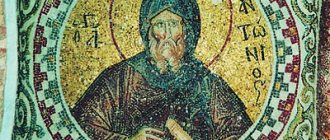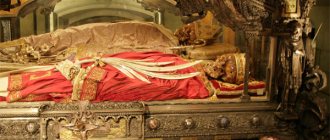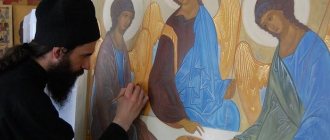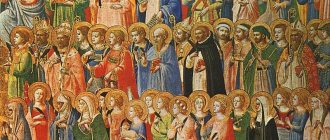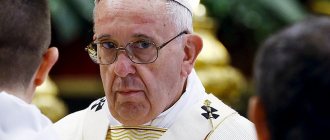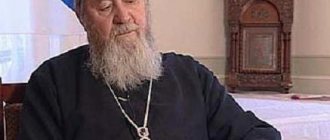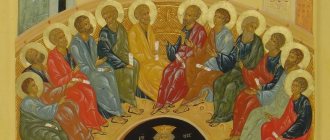St. Leo the Great, Pope, and his Tomos
Introduction
Saint Leo, the Great, Pope of Rome is one of the outstanding personalities in the history of the Ancient Church thanks to his versatile church and even political figure. The latter was caused by the deplorable state of the Western part of the Roman Empire, in which it found itself due to the strong onslaught of barbarian tribes during the era of the so-called “migration of peoples”. It was the influx of numerous barbarian peoples, mainly into the Western Empire, that led to its complete disappearance, to the death of the “Eternal City”. No less intense was the life of the Catholic Church, which, after centuries of persecution by pagan emperors, “emerged from the catacombs.” This happened after the final victory of Emperor Constantine the Great in 324 at Adrianople and the unification of the entire empire [1]
under the rule of a single virtually Christian emperor
[2]
the state of the outside world, however, this peaceful situation was disrupted by the sudden emergence of numerous dogmatic disputes.
“When tyranny fell and the autocratic Constantine began to rule the state as a Christian and defender of the Church, the Church felt so happy that some bishops almost lost their sense of proportion. They were unprepared to understand the new reality and confront the new shaking problems. We are talking about the problems created by the free life and activity of the Church, the need for its strict organization, the emergence of new dangerous heresies and the reason for the deepest and broadest theological explanation of the truth. However, this clarification should be done with the help of a philosophical word, the correct and judicious use of which by Christian theologians became an acute problem that was successfully resolved only by the great Fathers” [3]
, emphasizes S. Papdopoulos. In the 5th century after the end of the so-called.
trinitarian disputes at the III Ecumenical Council (431), disputes about the dignity of the Second Person of the Holy Trinity, disputes soon began about the image of the union of natures in the Person of the God-man Christ. These debates were no less intense than the anti-Arian ones. They lasted for more than a hundred years. For the Orthodox Church, these disputes were of a fundamental nature, since they all concerned the essence of the Christian faith. As is known, outstanding Church Fathers, such as St. Athanasius the Great, St. Gregory the Theologian, St. Basil the Great, St. Cyril of Alexandria, St. Flavian of Constantinople and St. Leo, Pope. We will talk about him and his contribution to the disclosure and formation of Orthodox Christology. [4]
St. Leo the Great and some biographical information
St. Leo the Great is often referred to by the title “Great - Magnus” for his versatile activities for the benefit of the Church of Christ, mainly Western. At that time, the Western Church was Orthodox and formed a single whole with the Eastern Apostolic Patriarchates (Alexandria, Antioch, Jerusalem, and later Constantinople), that is, the One Holy Catholic and Apostolic Church.
Basic biographical data of St. Leo is cited in such a fairly well-known monument of early medieval history as Liber Pontificales, which is a collection of basic biographical information about the Roman bishops from the Apostle Peter to Felix III (526-530). St. Leo was a native of Tuscany (natione Tuscus), his father belonged to a patrician family of noble Romans. In some manuscripts of St. The lion is called natione Romanus, which indicates his noble origin. {3}
His father's name was Quintianus
[5]
.
Year of birth of St. Leo is unknown. For a long time St. Leo was an archdeacon and secretary of the Roman popes St. Celestine and St. Sixtus III {4}
He had to carry out numerous orders from the popes on church affairs, as well as a number of diplomatic commissions from Emperor Valentinian III.
For example, he was tasked with reconciling two prominent political figures of late Roman history who were at war with each other: the general and commander-in-chief of the Roman troops in the provinces, Aetius, and the chief magistrate, Albinus. Intervention of St. Leo in the discord that occurred, which, before the active onslaught of the Huns on the empire, only played into the hands of the enemies of Rome, was completed with a successful peace. {5}
In church affairs of that time, St.
Leo is known for the reconciliation of the Gallic Church, and also for the fact that, on his urgent advice, the founder of Western monasticism, St. Benedict of Nursia writes a theological treatise of great importance for the Orthodox Church, “On the Incarnation of the Lord against Nestorius” (De Incarnatione Domini contra Nestorium). {6}
September 29, 440
Archdeacon Leo was ordained bishop, and after the blessed death of Pope Sixtus on November 10, 461. St. Leo was unanimously chosen as his successor. {6}
In the history of the Roman Church, the period of its existence as an Orthodox local church until 1054, St.
Leo is considered, like St. Gregory I the Great (VI century) the most outstanding personality. The same Liber Pontificales tells us about the most important act of his life - to wage an intense struggle against the heresies of Nestorius and Eutyches [7]
, as well as against the Manichaean heresy widespread in the West.
Leo I the Great, Pope of Rome. Constantinople. 985 Miniature. Minology of Vasily II. Vatican Library. Rome
Authoritative historical monuments describing the times of St. Leo the Great is reported on his enormous authority, pastoral energy, and zealous service to his flock and the entire Church. There are two known cases from the history of Rome, which are not just a legend, but a narration of real events. They clearly testify to the true ministry of St. Leo as the true shepherd of the Church, the defender of the people of God from her enemies. In 452 The famous leader of the Huns, Atilla, invaded northern Italy, destroyed a number of cities and really threatened Ravenna, then the residence of the emperors of the western part of the empire, and Rome itself. At the request of Emperor Valentinian III, St. Leo goes to Attila's camp, accompanied by two patricians: the consul Avienus and the prefect Trigetius. St. Leo rode in all his bishop's vestments. In the town of Minzio near Mantua a meeting of St. Leo and Attila. {7}
St.
Leo, calling Attila “the scourge of God,” ordered to leave Italy and return back. Anonymous author of the biography of St. Leo even preserved the words with which the Roman high priest addressed Atilla: “O Atilla, entire regions that were granted to the Romans thanks to victories over the peoples, so that they would be conquered by them, submitted to you. Now we pray that he who has conquered others will conquer himself. People felt your scourge. Now they would like to feel your mercy.” {8}
Some sources report Attila’s vision of two angels with burning swords and threatening to strike him if he refused to obey the word of the Roman high priest.
{9}
And in 455
he had to beg the leader of the Vandals, Heinseric, not to destroy or burn Rome. However, the city was ravaged by fire for four days. Only three churches survived. After the pogrom of St. Leo set about restoring the destroyed city and temples. Among them was the new temple of the Apostle Peter on Vatican Hill and St. much Sebastian on the Appian Way. This further raised the authority of St. Leo among the Romans. {10}
Meeting of St. Leo with Attila. Raphael Santi, Sistine Chapel, Rome
We will be primarily interested in the participation of St. Leo in the fight against the new heresy of Eutyches, one of the archimandrites and abbots of the monastery of the Church of Constantinople. Why do we dwell on this particular activity of St. Leo, and not the other? To understand this, it is necessary, first of all, to clearly understand that for the Holy Fathers any heresy is not just some kind of personal statement about God, a certain system of philosophy, but blasphemy against God. The Holy Fathers were a kind of indicators of Orthodoxy, and therefore they reacted with unprecedented zeal to any innovation in the faith, which, as a rule, turned out to be in disagreement with the teachings of the Church. The teaching of Eutyches, as discovered by St. Flavian, Archbishop of Constantinople, completely disagreed with the teachings of the Church, since this poorly educated archimandrite, supposedly being a strict follower of St. Cyril of Aleksandria, taught:
1. before the incarnation, Christ had two natures, and
2. after incarnation has one complex nature{11}
3. Eutyches rejected the most important thing - the coexistence of our human nature with the human nature perceived by the Lord.
Refuting the accusations of Archimandrite Eutyches of Nestorianism, St. Flavian, the latter writes a refutation of these opinions in the “List of Confession of Faith,” which was presented to Emperor Theodosius II: “Nothing is so required from a priest of God, enlightened by Divine dogmas, as that he be ready to satisfy everyone who demands an answer from him regarding our hope and grace...Therefore...we preach our one Lord Jesus Christ, born according to Divinity from God the Father without beginning before the world, in the last days for us and for the sake of our salvation (born) according to humanity from the Virgin Mary, perfect God and perfect man, according to perception rational soul and body, consubstantial with the Father in Divinity and consubstantial with the Mother in humanity. So, confessing Christ in two natures, after His incarnation from the Holy Virgin and incarnation, we confess in one hypostasis and one person one Christ, one Son, one Lord, and we do not deny that there is one nature of God the Word incarnate and incarnate; because of two natures one and the same is our Lord Jesus Christ.” {12}
Having learned from St. Flavian about the heresy of Eutyches that spread in Constantinople, St. Leo, in a letter to Empress Pulcheria, writes: “For what is now being discussed is not some insignificant particle of our faith, which would be less clear, but senseless opposition dares to attack what the Lord does not want to leave unknown to anyone in the entire Church.” {13}
The Council of Ephesus as one of the examples of convening false councils in the history of the Church
However, correspondence with St. Leo St. Flavian, in which the Roman high priest was completely on the side of the Bishop of Constantinople, did not lead to the desired results. Although in Ephesus in 449. and a council took place, but it was not the truth that was defended, but a lie. At this council, the chairmanship was taken by Dioscorus, Archbishop of Alexandria, who was a supporter of Archimandrite Eutyches. St. Leo writes a special message to the council in Ephesus. In this letter, he writes about sending his representatives to Ephesus: Bishop Julian, Presbyter Renatus, Deacon Hilary, and the scribe notary Dulcitius, so that they “condemn the disastrous error, even judge the restoration of the one who has gone astray unreasonably.” In addition, St. Leo wrote a letter to St. for reading at the cathedral. Flavian of Constantinople, which may be said to be an exposition of the faith of the Roman Church. In history, this famous message received the name Tomos of St. Leo, Pope of Rome. It condemned the teaching of Archmandrite Eutyches. It began with the following words: “Having read the message of your love, as belated to our surprise, and having examined the order of the episcopal acts, we finally learned what temptation happened to you and rebelled against the purity of the faith...” And further St. Leo writes: “And what is more wicked than wickedly speculating about faith and not following the wisest and most experienced... And what is confessed throughout the entire universe by the lips of all the regenerated, this old man does not yet understand in his heart...” {14}
However, this letter was hidden, and St. was convicted.
Flavian. Having learned about the robbery that took place at the cathedral in Ephesus, and about the beatings that St. suffered. Flavian, as well as about the unjust and outrageous acquittal of Eutyches and the condemnation of St. Flavian, St. Leo writes to the Patriarch of Constantinople: “What and how much your love endured in defense of the Catholic faith, we learned from the deacon {15}
who secretly fled from Ephesus.
And although we glorify God, who strengthens you with the power of His grace, we must, however, be pained by the fall of those through whom the truth is subjected to a fall and the very foundation of the whole Church is shaken...” {16}
St.
Flavian, Bishop Eusebius of Dorylaeum and Theodoret filed an appeal to St. Leo on the decisions of this council. Held in the same 449. year, the council in Rome declared the council held in Ephesus devoid of all power. {17}
The Council of Ephesus received the worthy name “robber” (ληστρική, latrocinium Ephesinum).
As the professor at the University of Athens, the famous dogmatist John Karmiris, notes, when the facts of what happened at the council in Ephesus were learned, “they were marked by serious indignation and opposition to the violent, hasty, wicked and very crafty decisions of it.” {18}
The Council of Ephesus serves as one of the most convincing proofs that not every council of bishops and even heads of local churches is ecumenical and expresses the truth.
As St. emphasizes. Leo the Great, in a letter to the people of Constantinople, “neither the rule of justice nor the piety of faith was observed there.” {19}
And Saint Leo, seeing what a “most evil crime” {20}
against the faith was committed at the council in Ephesus, appeals to Emperor Theodosius with an urgent request to convene a council in Italy to restore peace in the Church.
He writes to the emperor: “So, we confirm that the council of bishops, which you ordered to be convened in the city of Ephesus in the case of Flavian, contradicts the faith itself and inflicts a wound on all churches, which we learned not from some unreliable source, but from the most venerable bishops who were sent by us, and from the most faithful narrator of past incidents - our deacon Hilarus. And such guilt occurred due to the fact that those who were gathered did not express their opinions about faith and those who were lost from pure consciousness and correct judgment, as custom required...And you should not allow someone else’s sin to fall on you, because that we fear that he, whose piety has fallen, will not bring indignation upon you... Since some are now imprudently and wickedly contradicting this sacrament, with tears and lamentations all the churches of our regions, all the priests, implore your meekness... commanded an ecumenical council to be held within Italy , who would resolve or tame all the injustices that have arisen so that there would no longer be any doubt in faith, no division in love...” {21}
.
But Emperor Theodosius, under the influence of the courtier Chrysaphius, considered the decisions of the council in Ephesus to be correct. Intervention in church issues, at the request of St., also did not help. Leo, and Emperor Valentinian III. Emperor Theodosius wrote to his co-ruler in the West about the council in Ephesus: “And we know that they did nothing contrary to the rule of faith and justice. So, the whole dispute is ended by the sacred court. And Flavian, who was recognized as the culprit of the harmful novelty, received a worthy punishment.” {22}
The requests of the emperor’s mother, Empress Galla Placidia, to whom the emperor sent a response letter to her petition with the same content as he sent to Emperor Valentinian, were also unsuccessful.
Tomos of St. Leo the Great and the IV Ecumenical Council
However, the sudden death of Emperor Theodosius while hunting{23}
, to which St.
Leo made an urgent request to convene a new council, contributed to the acceleration of the convening of a new Ecumenical Council to condemn the “Ecumenical” Council, which unjustly deposed St. Flavian and the acquitter Eutyches. Before the new Ecumenical Council, the eastern part of the Church was shrouded in numerous unrest and disorder. And it was at this time that we mentioned the Tomos of St. Leo became a symbol and sign of Orthodoxy not only in the East, but also in the West. This document was copied in numerous quantities by the bishops of Gaul and other provinces of the Roman Empire, especially its western part. {24}
“The Bishop of Rome sent Flavian a famous dogmatic letter (Τόμος Λέοντος), which was probably written by the theologian Prosper.
He condemned in it the heretical teaching of Eutyches and put forward a strictly Dyophysite Christology, writes the prominent modern Greek professor and historian of the Church V. Fidas. [8]
“This letter emphasizes the sufficiency of the Nicene Creed for the faith of the Church and points to the soteriological value of the consubstantiality of the human nature of Christ with us.
However, the Lord’s victory over sin and death would have been impossible if God the Word, sinless and not afraid of death, “had not accepted our nature and made it his own” [9]
.
August 24, 450 Marcian was elected emperor. One of his main actions in the history of his reign over the Eastern Empire was, of course, the convening of the Ecumenical Council. Despite the requests of St. Leo to convene it in Italy, the imperial court decided otherwise. By the Emperor's Sacra of May 17, 451, the council was scheduled for September 1, 451. in Nicaea. The emperor considered it necessary to attend the cathedral personally, so for a number of reasons the cathedral was moved to Chalcedon, located opposite Constantinople on the Asian shore of the Bosphorus. However, some political events forced the opening of the cathedral to be postponed to a later time. The cathedral was opened on November 8, 451. 630 bishops were present at the council. {25}
St. Leo the Great. Modern icon, Russia
St. Leo sent his epistle to the council, which says: “I wished, most beloved, that out of love for our congregation, all the priests of the Lord would stand in the same reverence of the Catholic faith and that no one would succumb to either the flatteries or threats of worldly authorities, so that to deviate from the path of truth...Therefore, beloved brethren, having completely put aside the audacity to argue against the faith instilled in us from God, let the vain unbelief of those who go astray be silent. And one should not defend what one should not believe; because, on the basis of evangelical authority, prophetic inspirations and apostolic teaching, it was very clearly and completely set out in our messages, which we sent to Flavian of blessed memory, what piety and sincere confession should be regarding the sacrament of the incarnation of our Lord Jesus Christ ... " {26}
The council took place in the Church of the Holy Martyr. Euphemia of All Praise, and as the famous Russian church historian V.V. Bolotov writes, the main task of the council itself was not to condemn Dioscorus, Patriarch of Alexandria and his robber acts, but “to explain the Orthodox faith to the Orthodox world.” And it was precisely the meetings of the council, held on October 10, 17 and 22, that were devoted to the disclosure of the Orthodox faith about the God-Man, about the image of the union of two natures in the person of God the Word. At the council, the order of reading important doctrinal texts was observed, which were probably considered as symbolic doctrinal texts. The composition of the texts and the order of their reading were as follows: the Creed of Nicaea and Constantinople (our Creed), 2 Epistles of St. Cyril of Alexandria (an epistle to Nestorius, which is purely dogmatic in nature, as well as a conciliatory epistle to John of Antioch). After reading these doctrinal documents, the message of St. Leo, Pope of Rome to Archbishop Flavian of Constantinople, i.e. Tomos of St. Leo. {27}
The most significant place in this letter of St. Leo is the following: “Fruitfulness to the Virgin is bestowed by the Holy Spirit; and the true body is borrowed from her body. And when in this way Wisdom built herself a house, the Word became flesh and dwelt in us (John 1:14), i.e. in the flesh that It borrowed from man, and which it animated with the spirit of rational life.
Thus, while preserving the properties of both natures and combining them into one person, humiliation is perceived by greatness, weakness by power, and mortality by eternity. To pay the debt of our nature, the impassive nature was united with the passionate nature, so that one and the same, the Mediator of God and men, the man Christ Jesus (1 Tim. 2:15), could die according to one (nature) and could not die according to another , as required by the nature of our healing. Therefore the true God was born in the true and perfect nature of the true man; entirely in his own, entirely with ours. We call ours what the Creator placed us in the beginning, and what He wanted to return to us. For in the Savior there was not a trace of what the tempter brought into man, and what the deceived man allowed (into himself). And although He became a participant in human infirmities, it does not follow from this that He became a participant in our sins. He took on the form of a servant without the taint of sin.”
Tomos of St. Leo accurately expounding the Orthodox teaching on the Incarnation, as noted by Professor V.V. Bolotov, reconciles the theology of the Alexandrian school and the Antiochian school [10]
and “gives a harmonious combination of the best results of both.”
What did this reconciliation and combination consist of? To this, Professor V.V. Bolotov responds as follows: “In Antioch, the activity of humanity was promoted too energetically (which gave rise to the heresy of Nestorius, our note), in Alexandria, on the contrary, they left this side in the background. Leo explains that human nature in Christ is real, alive with all its properties, that humanity remains unchanged in him until death, and after the resurrection Christ appears with human flesh. Humanity not only exists in Him, it lives and acts. Christ is a perfect man with a truly personal fullness of life.” {28}
In our time, when in the course of theological dialogue with the so-called. The Oriental Eastern (Anti-Chalcedonian) is conducting, albeit sluggishly, a dialogue, it is necessary to note the following:
1. these Christian churches are strict followers, as they believe, of the teaching of St. Cyril of Alexandria about the “one nature of God the Word incarnate,” which rejects the heresy of Nestorius about the actually deified Man Christ,
2. These Christian denominations categorically reject the Tomos of St. Leo the Great and the definition of the Council of Chalcedon.
3. in Christology, they all adhere to the teaching of Severus of Antioch “about one complex nature” of God the Word incarnate. (Armenian Apostolic Church, Coptic Church, Malabar Church) {29}
,
4. Therefore, all of them, although they reject the Christology of Eutyches, but accepting the formulations of Severus of Antioch and rejecting the Tomos of St. Leo the Great and the definition of the IV Ecumenical Council are heretical,
5. and a necessary condition for joining with them is the recognition of the Tomos of St. Leo the Great and the definition of faith of the IV Ecumenical Council and subsequent councils of the Orthodox Church. {30}
As for the contents of the Tomos of St. Leo the Great and the formulations of St. Cyril of Alexandria about the “one nature of God the Word incarnate”, it is necessary to note that the Tomos does not contradict this formulation, but clarifies and clarifies it. [11]
At the same time, as V.V. also notes.
Bolotov St. Leo even uses the terminology of St. Gregory the Theologian. Another outstanding theologian of the Greek Church, Professor of the University of Thessaloniki, Professor Protopresbyter John Romanidis, touching on the question of the relationship between the wording of St. Cyril of Alexandria with Tomos of St. Leo and the creed of the IV Ecumenical Council writes: “There is no doubt that St. Leo sought to separate or differentiate the actions of Christ in such a way that the two natures seemed to act as separate substances, a tendency that was explained by the way he perceived the teaching of Eutyches, his position as a representative of the Latin West, since the Greek terms that were used in Christology were not for him are known, and he obviously could not understand how the term "one nature" was used in the East, and especially during the Council of 448. ... Nevertheless, emphasizes Fr. John Romanides - St. Leo very clearly, in his anti-Nestorian perception of the model of the Orthodox faith, accepted the teaching of St. Kirill. In his Tomos he quite clearly proclaims that “He, the eternal Father, the eternal Only Begotten, was born of the Holy Spirit and the Virgin Mary. This temporary birth did not subtract anything from that Divine and eternal birth, and did not add anything to it...” {31}
In the Acts of the Council of Chalcedon, which preserved the course and sequence of its meetings, there is important evidence that St. Leo shared the teachings of St. Kirill. {32}
After reading two important messages of the saint of Alexandria, the bishops of the cathedral unanimously declared: “We all believe so!
Papa Leo believes so much! Anathema to the one who divides and to the one who leaks! This is the faith of Archbishop Leo; Leo believes so; Lev and Anatoly believe so; We all believe so; Like Kirill, so we believe. Eternal memory to Kirill." {33}
And after reading the Tomos of St. Leo's bishops, as evidenced by church historians and Mansi, exclaimed that “through the mouth of Leo the Apostle Peter himself speaks,” “anathema to those who do not believe so; Peter spoke this through Leo; the Apostles taught this... Leo and Cyril teach accordingly; this is true faith; Orthodox Christians think so; This is the faith of the fathers." {34}
What St. Leo thought about the Incarnation, just like St. Cyril of Alexandria, is proven by himself in a letter to Bishop Julian of Kos. But not only that. As Professor I. Romanidis proves, at the council all the bishops were supporters of the teachings of St. Cyril and therefore for five days they carefully compared the text of the Tomos of St. Leo the Great with the Third Epistle of St. Cyril to Nestorius and 12 anathematisms. {35}
And this is precisely what gave all the bishops the right to assert the fidelity, Orthodoxy and accuracy of the Tomos of St.
Leo the Great. Church memory also preserves the story of the writing of St. Leo of this letter to St. Flavian against the heresy of Eutyches. St. Sophronius the Patriarch of Jerusalem in his famous “Spiritual Meadow” contains a story worthy of close attention about how St. After writing the text of the message, Leo placed it on the tomb of the Apostle Peter. For forty days the Roman saint fasted and prayerfully asked the Apostle to correct all the inaccuracies that had crept into the text. After which the Apostle Peter himself appeared to him and announced that he had corrected all the mistakes with his own hand. {36}
Church historian Evagrius Scholasticus Tomos of St. He characterizes Leo with these words: “For this epistle is in accordance with the confession of the great Peter, and is, as it were, a pillar against evil-minded people.” {37}
Despite the still insufficient refinement of the text of the Tomos of St. Leo, nevertheless, it formed the basis of the creed of the IV Ecumenical Council.
Mosaic icon of St. Leo the Great 9th century
We recall the main part of this definition of faith, which, like a razor blade, cut off and cut off from the Orthodox doctrine of Christ the distortions of Nestorianism and Monophysitism:
“Therefore, following the holy fathers, we all teach in agreement to confess one and the same Son, our Lord Jesus Christ, perfect in divinity and perfect in humanity, truly God and truly man, the same from the rational soul and body, consubstantial with the Father in Divinity and consubstantial with us in humanity, similar to us in everything except sin, born before the ages from the Father according to divinity, and in the last days for our sake and for the sake of our salvation from Mary the Virgin Mother of God in humanity, one and the same Christ, Son, only begotten Lord, in two natures{38}
unfused, unchangeable, inseparably, inseparably cognizable
{39}
- so that the union does not in the least violate the difference of two natures, but all the more the property of each nature is preserved and united into one person and one hypostasis...”
{40}
Church tradition sacredly preserves the memory of the miracle , perfect St. Vmch. Euphemia. The members of the council, wanting to be convinced of the Orthodoxy of the adopted council's definition of faith, acted as follows. Having opened the sarcophagus with the relics of St. Vmch. Euphemia, Patriarch Anatoly of Constantinople placed two scrolls on the incorruptible, fragrant body of the martyr: with the Orthodox confession and the confession of the followers of Dioscorus of Alexandria. A few days later, when the lid of the sarcophagus was opened again, the following sight was revealed to everyone: St. vlmch. Euphemia held in her hands the scroll of the Orthodox confession of faith we quoted above, and at her feet lay the confession of faith of the followers of Dioscorus. {41}
Undoubtedly, when comparing the text of the creed of the Council of Chalcedon and the Tomos of St. Lev, the enormous influence of the latter’s text on the final dogmatic document of the Ecumenical Council and its formation becomes obvious.
So, we emphasize once again that the Tomos of St. Leo is the most important doctrinal document, which the Church has always considered as a necessary foundation, the basis of the Orthodox teaching about Christ as the true God-Man, possessing in one Person (una persona) two perfect, true and complete natures after his incarnation from the Holy Virgin Mary and from the Holy Spirit. Therefore, the Orthodox Church considered the Tomos of St. Leo the Great as his symbolic book, a model of the Orthodox faith (τύπος πίστεως), and such an attitude towards the Tomos of St. Leo should be unchanged in the Church, and no one has the power to revise this attitude.
Hegumen Simeon (Gavrilchik)
, Candidate of Theology, Monastery of the Holy Trinity-Sergius Lavra
Notes:
[1]
See Στ.Γ. Παπαδοπούλος. Πατρολογία, τόμος.2, σελ.26
[2]
As you know, St. Emperor Constantine the Great received holy Baptism a year before his blessed death, but already during the First Ecumenical Council he was a catechumen.
[3]
Στ.Γ. Παπαδόπουλου. ΠΑΤΡΟΛΟΓΙΑ, τόμος.2,Ο ΤΕΤΕΡΤΟΣ ΑΙΟΝΑΣ (Ανατολή καί Δύση). Αθήναι 1990, σελ.26
[4]
We leave aside one of the most important problems that St. Leo, not without the help of imperial power, is the rise of the Roman See in the West above the rest, the development of the doctrine and primacy of the Pope in connection with the so-called. privileges of the Apostle Peter. We also do not touch upon the conflict that arose between Old and New Rome due to the granting of the primacy of honor to the Bishop of Constantinople by Canon 28. See Browner Nail. Leo Great/ The Early Church Fathers/
[5]
natione Tuscus, ex patre Quintiano. In Liber Pontificales XLVII Leo (440-461) https://www.thelatinlibrary.com/liberpontificalis1.html
[6]
— —
[7]
Hic inuenit duas hereses, Eutychiana et Nestoriana // Liber Pontificales
[8]
ΒΛΑΣΙΟΣ ΦΕΙΔΑΣ, Εκκλησιαστική Ιστορία, τ. α', Αθήναι 1994, σ.634
[9]
Nisi naturam nostrum ille susciperet et suam faceret
[10]
Professor Vlasios Fidas thinks a little differently: “The Christology of the Tomos of Leo triumphed not only over Eutyches, but also, mainly, over Alexandrian theology, which was sympathetic to the terminology about the one nature of Christ after the union. It is characteristic that Nestorius expressed his satisfaction with the rock terminology of the Tomos of Leo: 2When I found and read this text, I thanked God for the fact that the Roman Church was orthodox and impeccable in its profession of faith, despite the fact that it expressed a position different from mine." ΒΛΑΣΙΟΣ ΦΕΙΔΑΣ, Εκκλησιαστική Ιστορία, τ. α', Αθήναι 1994, σ.635
[11]
See comments regarding the content of the text of the tomos and the doctoral dissertation Αθανασίου,Αντωνάκης (2005, Εθνικό και Καποδιστριακό Πανεπιστήμι ο Αθηνών (ΕΚΠΑ)), Η διδασκαλία της εν Χαλκηδόνι Δ΄ Οικουμενικής συνόδου Κα ι ο αντιχαλκηδονισμός, Αρχαίος καισύγχρονος,σελ.103-109
* * *
{3}
History of the Christian Church, Volume III: Nicene and Post-Nicene Christianity. AD 311-600. and also in the Acta Sanctorum
{4}
V. Zadvorny. History of the Popes from St. Peter to St. Simplicia. M. 1995, vol. 1, p. 237 See also Catholic Encyclopedia (1913), Volume 9 Pope St. Leo I (the Great), by Johann Peter Kirsch. https://en.wikisource.org/wiki/Catholic_Encyclopedia_(1913)/Pope_St._Leo_I_(the_Great)
{5}
Original Catholic Encyclopedia. Pope Leo I, Saint
{6}
P.L. Migne L, 9 sqq.
{7}
Catholic Encyclopedia.CD-ROM. Pope. St. Leo I (The Great)/
{8}
Medieval: Sourcebook Leo I and Atilla/ https://www.fordham.edu/halsall/source/attila2.html
{9}
Original Catholic Encyclopedia. Pope Leo I, Saint, and historical monuments are indicated that give varying degrees of detail about this fact: Canisius, in the Vita Leonis (in the Acta Sanctorum, for the month of April, vol. ii. p. 18)
{10}
Prosper, Chron ad ann. 455
{11}
Acts of the Ecumenical Councils. St. Petersburg. 1996, vol. 2, p. 15 Epistle of St. Flavian of Constantinople, Archbishop Leo
{12}
Ibid., p. 17.
{13}
Ibid., p. 24
{14}
Acts of the Ecumenical Councils, vol. 2, pp. 231-232
{15}
This is Deacon Ilarius
{16}
Ibid., p. 31
{17}
Ibid., p. 259
{18}
? ική Εκκλησίας, Τόμος Α΄, σελίς 167
{19}
Ibid., p. 37
{20}
Ibid., p. 34
{21}
Ibid., p. 34
{22}
Ibid., p. 44
{23}
Although Yu. A. Kulakovsky, citing the historian Mansi, confidently says that the emperor was a staunch supporter of Dioscorus and believed that the council of 449. in Ephesus established lasting peace in the empire. Yu.A. Kulakovsky. History of Byzantium, years 395-518. St. Petersburg. Alithea. 1996, p. 249
{24}
See V. V. Bolotov. Lectures on the history of the Ancient Church. Reprint. Kyiv. 2007, vol. 4, p. 266
{25}
? ική Εκκλησίας, Τόμος Α΄, σελίς 156
{26}
Acts of the Ecumenical Councils, vol. 2, p. 52-53
{27}
V. V. Bolotov. Decree. works., p. 286
{28}
V. V. Bolotov. Decree. works., pp. 270-271
{29}
See Jean Claude Larcher. Historical foundations of anti-Chalcedonianism and Monophysitism of the Armenian Church (V - VIII centuries) // Theological Bulletin No. 7, 2008, pp. 144-196. On the influence of Severus of Antioch and Julian of Halicarnassus on the theology of the Armenian Church, see Ibid., pp. 177-189
{30}
Ἱερᾶ Κοινότης Ἁγίου Ὄρους Ἄθω, Παρατηρήσεις περί τοῦ θεολογικοῦ διάλογου Ὀρθοδόξων καί Ἀντιχαλκηδονίων, Ἄγιον Ὄρος, 1996
{31}
John S. Romanides. ST. CYRIL'S "ONE PHYSIS OR HYPOSTASIS OF GOD THE LOGOS INCARNATE" AND CHALCEDON.
{32}
Although, as is known at one of the last meetings, Bishop Atticus of Illyria strongly suggested comparing the text of the tomos and the third letter of St. Cyril to Nestorius with 12 anathematisms
{33}
Acts of the Ecumenical Councils., p. 231
{34}
Evagrius Scholasticus. Church history. M. 1997, book 2, 18, p. 91
{35}
John S. Romanides. ST. CYRIL'S "ONE PHYSIS OR HYPOSTASIS OF GOD THE LOGOS INCARNATE" AND CHALCEDON.
{36}
Spiritual Meadow, the creation of Blessed John Moschos. Sergiev Posad. 1915, pp. 174-175 words of the ap. Peter “read and corrected.” Next is the story of St. Eulogius, Patriarch of Alexandria and the appearance of St. to him. Leo after his blessed death and thanksgiving for the protection of his Tomos, but not only him personally, but the ap. Peter and the entire Church against heretics. p.175-176
{37}
Evagrius Scholasticus. Church history. M. Economic education. 1997, p. 57
{38}
ἐν δύο φύσεσιν
{39}
ἀσυγχύτως, ἀτρέπτως, ἀδιαιρέτως, ἀχωρίστως γνωριζόμενος
{40}
Quote according to V.V. Bolotov. Decree. works., p. 292
{41}
The Church commemorates this event liturgically on March 11, Old Style. Cm . Ωρολόγιον το Μέγα. Ἐν Ἀθήναι. 1977, Ἔκδ, τῆς Ἀποστολικῆς Διακονίας. σελ. 398-399
Tags: Hegumen Simeon (Gavrilchik)
March 6, 2017
Share
Proceedings[ | ]
Leo left behind a large collection of his works (96 sermons and 120 epistles[14]). His sermons cover the entire liturgical cycle: 10 sermons are dedicated to Christmas, 8 Epiphany, 12 Lent, 19 Holy Week, etc. As a historical source, Leo's sermons testify to the preservation of remnants of pagan cult and astrology[5]. Also in his sermons and epistles, the pope condemned Manichaeism ( Ser. 9.4; Epist. 7
), Monophysitism, Pelagianism and other heresies that came to Rome with traders from Egypt[15].
Letters from Leo I have been preserved. He corresponded with Eutyches and St. Flavian of Constantinople, in his letter to the Fourth Ecumenical Council[16], took the side of the latter. He subordinated the bishops of Illyria and Gaul to the primacy of St. Peter.
Literature[ | ]
- Kowalski J.
Period II. Under the tutelage of the Roman Empire // Popes and Papacy. - Norwich D.
History of the Papacy. - M., AST, 2014. - Pevnitsky V.F.
Saint Leo the Great and his sermons. - Kyiv, 1871. - Memory of our holy father Leo, Pope of Rome // Lives of the saints in Russian, set out according to the guidance of the Chetyih-Menya of St. Demetrius of Rostov: 12 books, 2 books. add. - M.: Moscow. Synod. typ., 1903-1916. — Vol. VI: February, Day 18.
foreign language
- Murphy FX
Leo I, Pope, St. // New Catholic Encyclopedia. — 2nd ed. - 2003. - T. 8. - P. 474-478. — ISBN 0-7876-4012-3. - Wessel S.
Leo the Great and the Spiritual Rebuilding of a Universal Rome. - BRILL, 2008. - T. 93. - 422 p. — (Vigiliae Christianae, Supplements). — ISBN 978-90-04-17052-0.
Notes[ | ]
- Wessel, 2008, pp. 34-35.
- Wessel, 2008, p. 35.
- Wessel, 2008, p. 36.
- Wessel, 2008, p. 37.
- ↑ 12
Murphy, 2003, p. 475. - Wessel, 2008, p. 38.
- Gregorovius F.
History of the city of Rome in the Middle Ages. — 2008. - Wessel, 2008, pp. 45-47.
- Wessel, 2008, pp. 47-48.
- ↑ 12
Wessel, 2008, p. 50. - John Norwich.
History of the Papacy / Trans. from English A. V. Korolenkov. - 1st ed. - M,: AST, 2014. - P. 38. - ISBN 978-5-17-080844-1. - Wessel, 2008, p. 39.
- Wessel, 2008, p. 40.
- ↑ 1 2 Kowalski Y.
Period II. Under the tutelage of the Roman Empire // Popes and papacy. - Murphy, 2003, p. 476.
- Leo the Great, St. Message to the bishops who gathered at the Holy Council of Chalcedon
- Wessel, 2008, p. 1.

